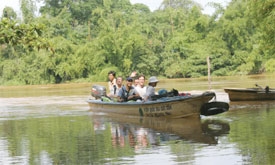Power projects stalk a wildlife rich park
 Local scientists and the park’s authority are concerned that the important 71,920 hectare park could become home to two large-scale hydroelectricity projects.
Local scientists and the park’s authority are concerned that the important 71,920 hectare park could become home to two large-scale hydroelectricity projects.
Currently in the design phase, the 135 megaWatt Dong Nai 6 and the 106MW Dong Nai 6A would occupy over 370ha of the park, which was selected by the UNESCO as a world’s biosphere reserve in 2001. The plants would also swallow up a further 144ha of Southern Cat Tien protection forest.
Deputy Prime Minister Hoang Trung Hai in September, 2009 agreed in principle on adding these two projects to the government’s list of national power projects in between 2006-2015 and vision to 2025.
Earlier, the Ministry of Agriculture and Rural Development (MARD) asked the government for permission to build these two projects.
However, under the National Assembly’s Resolution 66 dated June 29, 2006, the transformation of any 50 hectares of national or special forests into other non-forest purposes must be considered and approved by the National Assembly.
Also, construction of the projects would violate the 2008 Law on Biological Diversity, according to the park’s director Tran Van Thanh.
Thanh said the law prohibited all projects in conservation zones except for defence and security installations.
Some other experts have also frowned upon these two projects.
“Besides these two hydropower projects, many others are being prepared. I am very concerned that changes to the river system will result in changes to the current situation of the wetlands in the park,” said Nguyen Dinh Xuan, director of the Lo Go-Xa Mat National Park in Tay Ninh province.
“Construction of these two projects will seriously harm the park’s biological diversity. It is really alarming. I don’t understand why hydroelectricity planning is being managed that way,” said Pham Binh Quyen, general secretary of Vietnam Association for Conservation of Nature and the Environment.
But Tran Ba Hiep, director of the projects, said the forest area used for the two projects was “negligible”, and the land’s quality was low with no rare fauna and flora under protection there.
“It is clear that the two projects would affect the park. But 45 of Vietnam’s total 143 national parks have big hydroelectricity projects. And our two projects use up the least forest area as compared to other projects of this type,” Hiep said.
Ha Cong Tuan, head of the MARD’s Forest Protection Department, said construction of these two projects would not significantly affect the park’s ecological values.
“These projects are in line with the national power planning. But, we will seek more consideration from the prime minister about the fate of these two projects,” Tuan said.
In August, 2010, during her talks with Deputy Prime Minister Nguyen Thien Nhan, Katherine Muller Marin, who is chief representative of UNESCO Office in Hanoi, said the organisatin would support Vietnam in processing procedures for the park to be recognised as a world natural heritage.
Home to 1,600 species of flora, the park, based in Dong Nai, Lam Dong, Binh Phuoc and Dak Nong provinces, has 105 listed mammal species, 351 species of birds, over 120 reptile and amphibian species and over 130 species of freshwater fish.
What the stars mean:
★ Poor ★ ★ Promising ★★★ Good ★★★★ Very good ★★★★★ Exceptional
Related Contents
Latest News
More News
- Global partnerships key to Vietnam’s IFC development (December 26, 2025 | 16:18)
- Vingroup pulls out of bid to invest in North-South high-speed railway (December 26, 2025 | 11:42)
- Strengthening supply chains through trade promotions and customs reform (December 24, 2025 | 14:00)
- PM orders investment model for North–South high-speed rail (December 22, 2025 | 17:43)
- LS Eco Energy to invest in Vietnam rare earth sector (December 22, 2025 | 17:31)
- Government moves to establish International Financial Centre (December 21, 2025 | 21:00)
- Vietnam's IFC to target global investment flows (December 21, 2025 | 18:00)
- Two national hospitals expand capacity with new facilities (December 20, 2025 | 09:00)
- Ha Tinh breaks ground on major Vingroup industrial and energy projects (December 19, 2025 | 18:24)
- EVN launches major power infrastructure projects nationwide (December 19, 2025 | 18:17)

 Tag:
Tag:





















 Mobile Version
Mobile Version